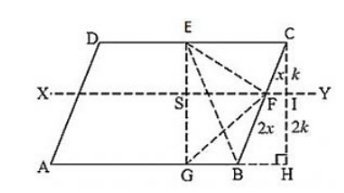ABCD is a parallelogram. G is a point on AB such that AG = 2GB and E is point on DC such that CE = 2DE and F is the point of BC such that BF = 2FC. Prove that:
(i) ar(ADEG) = ar(GBCE)
(ii) ar(ΔEGB) = (1/6) ar(ABCD)
(iii) ar(ΔEFC) = (1/2) ar(ΔEBF)
(iv) ar(ΔEGB) = 3/2 × ar(ΔEFC)
(v) Find what portion of the area of parallelogram is the area of ΔEFG.
Given: ABCD is a parallelogram
AG = 2 GB, CE = 2 DE and BF = 2 FC
To prove:
(i) ar(ADEG) = ar(GBCE).
(ii) ar(ΔEGB) = (1/6) ar(ABCD).
(iii) ar(ΔEFC) = (1/2) ar(ΔEBF).
(iv) ar(ΔEGB) = (3/2) × ar(ΔEFC)
(v) Find what portion of the area of parallelogram is the area of ΔEFG.
Construction: Draw a parallel line to AB through point F and a perpendicular line to AB from C
Proof:

(i) Since ABCD is a parallelogram
So, AB = CD and AD = BC
Consider the two trapezium s ADEG and GBCE
Since AB = DC, EC = 2DE, AG = 2GB
⇒ ED = (1/3) CD = (1/3) AB and EC = (2/3) CD = (2/3) AB
⇒ AG = (2/3) AB and BG = (1/3) AB
So, DE + AG = (1/3) AB + (2/3) AB = AB and EC + BG = (2/3) AB + (1/3) AB = AB
Since the two trapezium ADEG and GBCE have same height and their sum of two parallel sides are equal
Since
Area of trapezium $=\frac{\text { Sum of parallel sides }}{2} \times$ height
So, ar(ADEG) = ar(GBCE).
(ii) Since we know from above that
BG = (1/2) AB So
ar(ΔEGB) = (1/2) × GB × Height
ar(ΔEGB) = (1/2) × (1/3) × AB × Height
ar(ΔEGB) = (1/6) × AB × Height
ar(ΔEGB) = (1/6) ar(ABCD).
(iii) Since height if triangle EFC and EBF are equal. So
ar(ΔEFC) = (1/2) × FC × Height
ar(ΔEFC) = (1/2) × (1/2) × FB × Height
ar(ΔEFC) = (1/2) ar(EBF)
Hence, ar(ΔEFC) = (1/2) ar(ΔEBF).
(iv) Consider the trapezium in which
ar(EGBC) = ar(ΔEGB) + ar(ΔEBF) + ar(ΔEFC)
⇒ (1/2) ar(ABCD) = (1/6) ar(ABCD) + 2ar(ΔEFC) + ar(ΔEFC)
⇒ (1/3) ar(ABCD) = 3 ar(ΔEFC)
⇒ ar(ΔEFC) = (1/9) ar(ABCD)
Now from (ii) part we have
ar(ΔEGB) = (1/6) ar(ΔEFC)
ar(ΔEGB) = (3/2) × (1/9) ar(ABCD)
ar(ΔEGB) = (3/2) ar(ΔEFC)
∴ ar(ΔEGB) = (3/2) ar(ΔEFC)
(v) In the figure it is given that FB = 2CF.
Let CF = x and FB = 2x.
Now consider the two triangles CFI and CBH which are similar triangle.
So by the property of similar triangle CI = k and IH = 2k
Now consider the triangle EGF in which
ar(ΔEFG) = ar(ΔESF) + ar(ΔSGF)
ar(ΔEFG) = (1/2) SF × k + (1/2) SF × 2k
ar(ΔEFG) = (3/2) SF × k ⋅⋅⋅ (i)
Now,
ar(ΔEGBC) = ar(SGBF) + ar(ESFC)
ar(ΔEGBC) = (1/2)(SF + GB) × 2k + (1/2)(SF + EC) × k
ar(ΔEGBC) = (3/2) k × SF + (GB + (1/2)EC) × k
ar(ΔEGBC) = (3/2) k × SF + (1/3 AB + (1/2) × (2/3) AB) × k
(1/2) ar(ΔABCD) = (3/2) k × SF + (2/3) AB × k
⇒ ar(ΔABCD) = 3k × SF + (4/3) AB × k [Multiply both sides by 2]
⇒ ar(ΔABCD) = 3k × SF + 4/9 ar(ABCD)
⇒ k × SF = (5/27 )ar(ABCD) ⋅⋅⋅⋅ (2)
From 1 and 2 we have,
ar(ΔEFG) = (3/2) × (5/27) ar(ABCD)
ar(ΔEFG) = (5/18) ar(ABCD)
Click here to get exam-ready with eSaral
For making your preparation journey smoother of JEE, NEET and Class 8 to 10, grab our app now.
